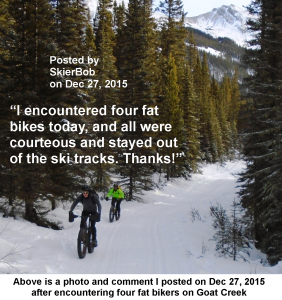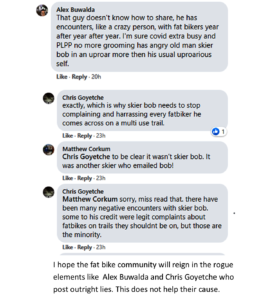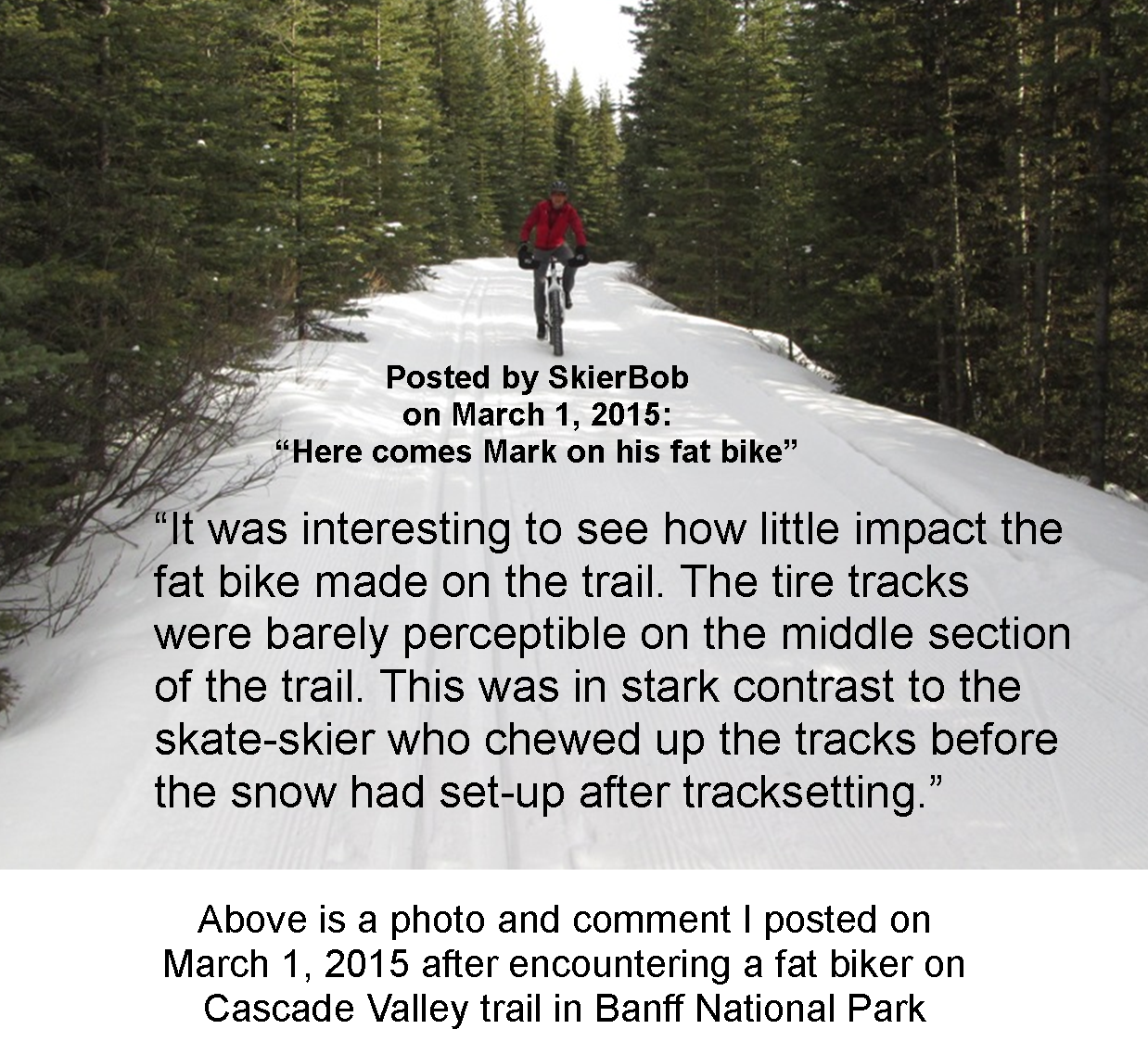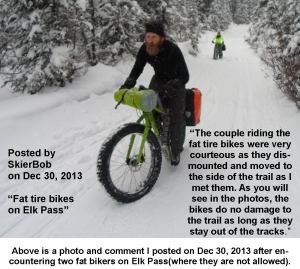I try to live my life with the motto of “turning negatives into positives,” but not everyone shares those ideals. Charles’ encounter with a fat biker, Matthew Corkum, which is really a good news story, has been twisted and turned into a diatribe against skiers by a few fat bikers who can’t seem to take “yes” for an answer. You can read Charles’ letter on my previous post Snowfall Update. The fat bikers comments are on the Facebook group Bow Valley Fat-Bike Riders.
 My encounters with fat bikers who are following the rules have all been positive, evidenced by the photos on this page. Even the encounters where I’ve seen fat bikers damaging soft, freshly-groomed trails, have been used as educational tools in the hope that all can benefit from being informed.
My encounters with fat bikers who are following the rules have all been positive, evidenced by the photos on this page. Even the encounters where I’ve seen fat bikers damaging soft, freshly-groomed trails, have been used as educational tools in the hope that all can benefit from being informed.
I understand why skiers, especially older ones, have a difficult time accepting fat bikers on the trail. I’ve made it clear many times on my blog that fat bikes don’t damage the trail if they’re doing it properly, and I believe attitudes are slowly changing, but there will always be a small percentage who don’t want to share.
Charles’ letter is evidence of the ability of skiers to adjust their attitudes. How do we get the misinformed fat bikers to change their attitudes?As you can see from the ignorant comments(posted to the side), with no evidence or attribution, some fat bikers have a pre-conceived notion that I am their enemy when in fact just the opposite is true.
 I worked with Banff National Park on the reconfiguration of Goat Creek so that fat bikes would have their own lane, reducing conflict with skiers. This in fact took away one track from skiers, but made it safer and more fun for everyone.
I worked with Banff National Park on the reconfiguration of Goat Creek so that fat bikes would have their own lane, reducing conflict with skiers. This in fact took away one track from skiers, but made it safer and more fun for everyone.
You have ill-informed, hardened attitudes from a very small contingent on both sides and I expect it’s just human nature to try and defend your turf. 99% of fat bikers are conscientious and respectful. It’s too bad a few of them had to turn a positive into a negative, or to use a sports term, grabbing defeat from the jaws of victory.
Please be respectful with your comments. You can disagree without being disagreeable.



Unfortunately due to Covid we will be seeing a LOT more trail users out there… of all types: Walkers, classic skiers, s’shoers, skate skiers, fat bikers and skinnier-tired-fat bikers. Since so many of them are relatively new to their respective sports and perhaps don’t crossover much, they will require patience and education. Many will end up on some of the wrong trails, some by accident and others by ignorance. Education starts at the shops they buy gear from, from trailhead signs, from other infrastructure users, and from being open to conversations and education. So I would ask the question of how can we include the local shops in the educating process? So if we go looking for conflict it’s pretty easy to find it, whereas if we go looking to share and educate you will most often find friendly reception.
My grinds with fat bikers is only with those who run down track sets which is exceedingly rare, those that do not stay to the side of the trail on blind downhill corners and those that bike illegally on trails closed to bikers.
Other than that, they are ok on limited trails as bikes do far less environmental damage on snow covered trails as compared to dirt trails- ie ruts from bikes that lead to more erosion and debris entering fish bearing streams and rut erosion harm to trails which make hiking more difficult and increase trail maintenance costs.
Technically, Parks Canada should limit the speed of biking in the parks, like the City of Calgary does, on the bike trails to a maximum of 20 kph for safety purposes. The bikers are more of a hazard to hikers on certain hiking trails with blind downhill corners than skiers as they can move much quicker on solid ground than typical winter snow. Speed can be used in court cases involving accidents to help determine negligence or fault.
If Parks Canada does not have a biker responsibility code, it better move it’s butt and develop one for legal liability purposes. Parks Canada could be held legally responsible in the event of an accident on its trails which it controls and permits bikes to be utilized. We don’t need Parks Canada wasting more money on court cases than it already does because the Superintendent or Minister of Environment is too ignorant or lazy to develop a biker responsibility code for within Park boundaries.
As a hiker who has been highly injured in a crash by a bike going to fast downhill around a blind corner, I believe a biker responsibility code would be an excellent idea as it would simplify any court cases involving such accidents and educate people to be more careful riding. Making court cases simple also means less lawyer costs for the injured or crash victims which is greatly needed to keep money in the pockets of the injured.
If you ever do get hit by a biker, take pictures immediately for evidence purposes.
Keep on biking and skiing as safe as possible to keep the fun for all out there.
I’m not a fatbiker, but I’m doubtful radar traps are the answer here. Would we restrict skiers to 20km/hr also? Would be the fair thing to do, but that’s ridiculously slow. You’d need to snowplow down the entirety of Moraine Lake Road.
Injuries caused by cyclists are vanishingly rare. Despite being hyped by the media, these incidents are a tiny fraction of a percentage of traffic injuries and deaths worldwide.
So let’s all take a deep breath, ease off on the litigation talk, and learn to see the world from other points of view. The world has enough antagonism already.